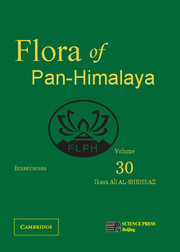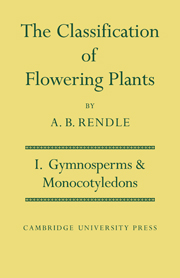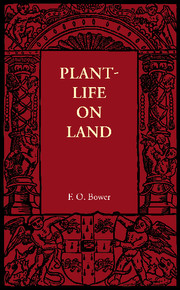Brassicaceae
Volume 30 of the Flora of Pan-Himalaya is devoted to the mustard family (Brassicaceae or Cruciferae). The Brassicaceae is one of the most natural plant families, and it is distributed on all continents except Antarctica, though mainly in the temperate, alpine, and subarctic areas. The highest diversity of the family is in the Irano-Turanian region, followed by western North America, the Mediterranean region, the Andes of South America, and the Himalayan region. The nomenclatural novelties in this volume include the new species Lepidium densipuberulum and Sisymbrium nepalense, and the new name L. cuneiforme. Furthermore, the lectotypes of Aphragmus tibeticus, A. stewartii, Braya rubicundula, Cardamine calcicola, C. impatiens var. elongata, C. weixiensis, Draba lichiangensis, Eutrema deltoideum var. grandiflorum, E. przewalskii, E. sherriffii, Hemilophia serpens, Noccaea cochlearioides, Parrya chitralensis, Pyconplinthus uniflora, Solms-laubachia minor, and S.-L. xerophyta are newly designated.
- A culmination of over ten years of work in collecting and identifying plants, many of which were previously unknown
- Covers the whole Himalayan region
- An indispensable resource for all those involved in plant conservation, biodiversity and taxonomy
Product details
December 2016Hardback
9781107158986
612 pages
267 × 191 × 35 mm
1.41kg
Available
Table of Contents
- Foreword
- Introduction
- Preface
- Acknowledgements
- Part I. Brassicaceae:
- 1. Alyssum
- 2. Calymmatium
- 3. Olimarabidopsis
- 4. Notoceras
- 5. Matthiola
- 6. Aphragmus
- 7. Acirostrum
- 8. Arabis
- 9. Arcyosperma
- 10. Baimashania
- 11. Dendroarabis
- 12. Draba
- 13. Parryodes
- 14. Scapiarabis
- 15. Sinoarabis
- 16. Megadenia
- 17. Brassica
- 18. Crambe
- 19. Diplotaxis
- 20. Eruca
- 21. Raphanus
- 22. Rapistrum
- 23. Sinapis
- 24. Goldbachia
- 25. Arabidopsis
- 26. Camelina
- 27. Capsella
- 28. Catolobus
- 29. Neslia
- 30. Barbarea
- 31. Cardamine
- 32. Nasturtium
- 33. Rorippa
- 34. Chorispora
- 35. Litwinowia
- 36. Parrya
- 37. Noccaea
- 38. Conringia
- 39. Crucihimalaya
- 40. Ladakiella
- 41. Descurainia
- 42. Hornungia
- 43. Ianhedgea
- 44. Dontostemon
- 45. Erysimum
- 46. Atelanthera
- 47. Braya
- 48. Christolea
- 49. Dilophia
- 50. Euclidium
- 51. Leiospora
- 52. Lepidostemon
- 53. Neotorularia
- 54. Pycnoplinthopsis
- 55. Pycnoplinthus
- 56. Shangrilaia
- 57. Sisymbriopsis
- 58. Solms-Laubachia
- 59. Strigosella
- 60. Tetracme
- 61. Eutrema
- 62. Pegaeophyton
- 63. Isatis
- 64. Lepidium
- 65. Megacarpaea
- 66. Shehbazia
- 67. Sisymbrium
- 68. Smelowskia
- 69. Stevenia
- 70. Alliaria
- 71. Didymophysa
- 72. Graellsia
- 73. Pseudocamelina
- 74. Thlaspi
- 75. Turritis
- 76. Yinshania
- 77. Asperuginoides
- 78. Dipoma
- 79. Hemilophia
- General references
- Index to scientific names.






